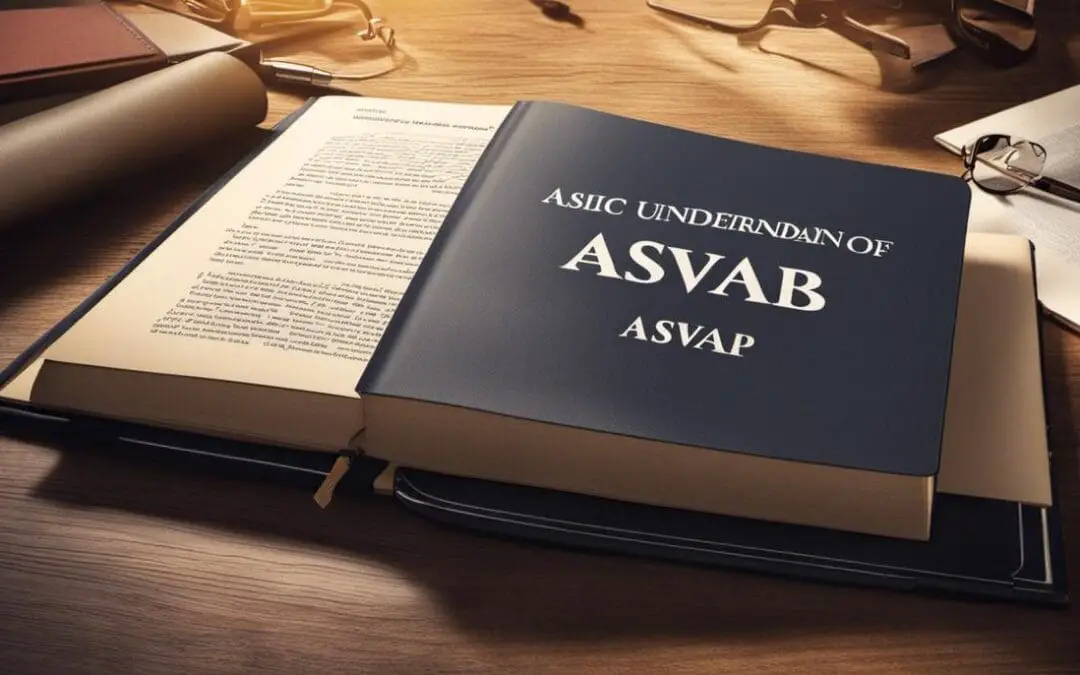Rigorous tours of duty in the necessity of national safety and the upholding of national values are fundamental aspects that invigorate brave individuals to aspire to join the U.S. Military. To streamline the recruitment process and accurately evaluate the aptitude of these budding warriors, the U.S. Armed Forces utilizes the Armed Services Vocational Aptitude Battery, or ASVAB, an indispensable tool that comprehensively probes into a potential recruit’s competencies. This well-structured examination delves into multiple areas of cognition and skills, ranging across subjects such as General Science, Arithmetic Reasoning, Word Knowledge, Paragraph Composition, and more. Appreciating the pivotal role of ASVAB scores in shaping a promising military career, we shall delve into its intricacies, uncovering useful strategies to improve outcomes and contemplating the future trajectory of the exam in the light of technological enhancements and digitization.
Basic Understanding of ASVAB
The Core Understanding of the ASVAB: The Keystone of Military Recruitment
The Armed Services Vocational Aptitude Battery (ASVAB) represents a fundamental and compelling component within modern military recruitment processes. This versatile assessment tool holds relevance far beyond its traditional interpretation as a mere admission exam—it is a central instrument for determining prospective military career paths.
A product of extensive research, the ASVAB was designed to evaluate and illuminate the aptitudes of potential recruits. Through multiple subtests, each focused on varying areas such as mathematics, science, technical skills, and comprehension abilities, the ASVAB yields comprehensive results of an individual’s potential within multiple career fields. Thus, its application extends beyond initial recruitment, significantly aiding in the careful selection and placement of the recruit into an appropriate career path within the military.
Comprehending the fundamental principles behind the ASVAB does not merely involve understanding its structure and the content. Instead, it requires a deep understanding of its socio-strategic significance. Harnessing the data obtainable from the ASVAB allows military recruiters to align placement with ability, therefore effectually optimising both individual potential and collective productivity within the military.
The methodical importance of the ASVAB can further be understood through its predictive validity. Utilized as a bellwether for future performance, the test results not only serve as a measure of current aptitude and knowledge, but also as a projection of potential performance in further training and education programs.
Moreover, the ASVAB’s implications extend to the broader landscape of socio-economic mobility. Contrary to traditional secondary education systems, the military often hosts an array of vocational opportunities for individuals with diverse skills and abilities. The test plays a critical role in identifying these aptitudes, hence, empowering individuals to exploit opportunities they may otherwise have been unaware of.
The ASVAB also has an intrinsic value as an educational tool. Its administration in high schools opens channels for self-reflection among students, offering insight into their potential vocational aptitudes. This aspect of the ASVAB contributes to the well-rounded development of the individual, leading to increased self-awareness and career readiness.
In the grand portrait of military recruitment, the ASVAB is undoubtedly a strategic painting tool. Its significance is apparent—irrespective of the angle of observation one takes. As such, a comprehensive understanding of the ASVAB is not simply implicative of the test itself but denotes an appreciation for a holistic, strategic, and data-driven approach to recruitment. It underlines the transition from a one-dimensional evaluation perspective, to a multifaceted methodology— thus redefining the landscape of military recruitment.

Various Subjects in ASVAB
Shifting the lens to a more granular level, the ASVAB maintains a comprehensive set of subjects. The test consists of ten distinct sections that each reflect a specific skill domain pertinent to successful military function. These include:
- General Science: This section integrates the basic principles of physical, biological and earth sciences. Mastery of this section points to an aptitude for roles that require scientific comprehension and problem-solving.
- Arithmetic Reasoning: The section evaluates the basic mathematical problem-solving skills and numerical reasoning proficiency. Performance in this area can indicate potential success in roles that involve complex calculations and logical problem-solving.
- Word Knowledge and Paragraph Comprehension: These sections are intertwined, focusing on verbal and linguistic capabilities. Word knowledge assesses the examinee’s vocabulary and understanding of synonyms, while Paragraph Comprehension evaluates an individual’s understanding of written information. Together, these sections inform about a soldier’s potential ability to interpret and effectively use written or verbal information – skills integral to communication-based roles.
- Mathematics Knowledge: This section tests more advanced mathematical skills including concepts of geometry and algebra. Proficiency in these areas may suggest an aptitude for technical roles requiring mathematical application, like engineering or coding.
- Electronics Information: Covers knowledge on electronic systems, devices, circuits, and the principles underpinning their function.
- Auto and Shop Information: Explores familiarity with automotive machinery and shop terminologies.
- Mechanical Comprehension: Gauges understanding of mechanical and physical principles.
- Assembling Objects: Gauges spatial-visual understanding, testing a candidate’s ability to perceive spatial relationships and manipulate objects in a spatial field.
Each section, while distinctive, intersects within the lattice of military operations, and the multidomain profile rendered by the ASVAB test results aids in assigning vocationally fitted positions. The structure of the ASVAB thus reflects an insightful melding of diverse skill sets and knowledge domains in its pursuit of optimal assignment, further illustrating its role in fortifying an effective, coherent military force.

Tips for Score Maximization
Having established the pivotal importance and multi-faceted functionality of the ASVAB examination, it is paramount to examine the tactical and strategic methodologies that a candidate can employ to maximize scores.
A holistic preparation strategy that covers all the content and competencies tested by the ASVAB is critical, and should be undertaken with ample lead time before the examination date to ensure optimal performance. This comprehensive preparation must encompass:
- General Science Knowledge
- Arithmetic Reasoning
- Word Knowledge
- Paragraph Comprehension
- Mathematics Knowledge
- Electronics Information
- Auto and Shop Information
- Mechanical Comprehension
- Assembling Objects
At the outset, understanding the detailed blueprint of each section is crucial. Mastering the content while simultaneously comprehending the underpinning structures of question types can greatly enhance performance. Knowledge of a topic is important, but it is equally imperative to decrypt how the ASVAB evaluates that knowledge. For instance, Arithmetic Reasoning is not just about performing computations, but interpreting word problems and applying mathematical principles pragmatically.
Furthermore, consistent practice coupled with an assessment of strengths and weaknesses expedites skill mastery. Engaging in repeated timed testing aids in the development of a pace management strategy significant for a timed exam like the ASVAB. To embark on this venture, utilize practice exams and dedicated study manuals that simulate the structure of the ASVAB.
A sound knowledge of fundamental vocabulary is indispensable for excelling in areas such as Word Knowledge and Paragraph Comprehension. Similarly, foundational mathematical concepts are integral to Arithmetic Reasoning and Mathematics Knowledge. For the sections on Electronics Information, Auto and Shop Information, and Mechanical Comprehension, securing knowledge in basic principles of physics, electricity, and mechanics is recommended.
Assembling Objects, a unique section not typically found in standard exams, requires a level of spatial intelligence and understanding of schematic diagrams. Thus, exercises to boost the aforementioned skill set are advised.
On the cusp of the examination day, a well-rested mind will serve as the ideal vessel to carry all the knowledge amassed. Over-aggressive last-minute attempts at studying can potentially induce anxiety and counterproductively impair recall abilities.
In conclusion, achieving top scores on the ASVAB examination necessitates a multi-faceted approach; a balanced blend of content mastery, understanding the mechanics of question types, consistent and timely practice, pacing strategies, and a healthy physical and mental state. Such a robust strategy not only prepares the candidate for the ASVAB but also contributes to robust, lifetime learning capabilities.
Remember, the ASVAB functions beyond a military placement tool; it is a snapshot of a candidate’s aptitude in multiple disciplines — a snapshot that, when enriched by strategic practices, can open vistas to a world of diverse vocational potentials.

Impact of ASVAB Scores on Military Career Outlook
In delving deeper into the impact of Armed Services Vocational Aptitude Battery (ASVAB) scores on a servicemember’s trajectory, it becomes evident that such scores significantly influence multiple facets of their military career. To grapple with the gravity of these scores, one must tread carefully across the intersection of aptitude, career development, and the military landscape.
The AFQT scores derived from the ASVAB examination are potently instrumental in informing a candidate’s eligibility to enlist within the various branches of military service. Alongside meeting basic eligibility criteria, the AFQT score, derived from subsets of the ASVAB, is of paramount import, determining whether an individual qualifies for military service, thereby encapsulating the cruciality of ASVAB performance. Higher ASVAB scores not only unbar the doors for entry but vivify the prospect of elevated roles, wider career options and access to incentives.
A soldier’s line score, comprehensively derived from various areas of the ASVAB, is another potent determinant of the available training programs they are eligible for. Therefore, more than simply a benchmark for enlistment, the ASVAB holds firm its grip on the lance of career progression. Good line scores can unlock the keys to highly sought technical and specialist roles, including intelligence, engineering, and aviation occupations. Such roles often offer additional benefits, including higher pay and promising career advancement opportunities.
The influence of the ASVAB does not waver post-enlistment. When considering promotions, particularly within noncommissioned officer ranks, the ASVAB scores can be pivotal. Commanders often reflect upon these scores as a part of the evaluation process, underlining an individual’s cognitive abilities and potential to assume greater responsibility. Military retention policies may also consider original ASVAB scores to evaluate a servicemember’s aptitude and performance over time, underscoring the ASVAB’s permeating influence across a military career.
Moreover, should a servicemember elect to transition from an active duty position into the civilian workforce, the ASVAB scores can gain significance anew. Skills verified by high ASVAB scores often dovetail with civilian sectors of employment, thereby aiding in occupational transition and enhancing employability. For instance, strong performances in the mechanics and electronics sections often map onto roles within the civilian automotive, aviation, and electronic sectors, respectively.
Hence, the scores earned on the ASVAB are not to be glossed over. They firmly clasp the reins of one’s military trajectory, steering careers and opening gateways. Whether contemplating initial enlistment, career advancements, or transitioning to civilian life, the ASVAB requires an individual’s serious attention and preparation. Through comprehensive understanding of content, strategic preparation, and diligent practice, it’s possible to maximize ASVAB scores and thereby illuminate the multitude of occupational prospects it holds before the servicemembers.

Future Innovations and Changes in ASVAB
The evolution of the ASVAB in the modern landscape is a fascination that has elicited much scholarly interest. With the advent of technological and intellectual advancements, there exists a palpable shift in the functionalities and dynamics of this critical military recruitment tool. The intersection between these new-age advancements and the ASVAB is poised to reshape the future conduct and interpretation of this deeply significant examination.
In recent years, the ASVAB’s content and structure have consistently been recalibrated to reflect the evolving demands and needs of the modern military industry. The adaptive nature of the ASVAB is integral to maintaining its relevance against the backdrop of rapid changes in technological sophistication, employment landscapes, and sociopolitical dynamics. As such, one anticipates alterations and enhancements addressing new technological domains, evolving operational procedures, and growing complexities in the military decision-making processes.
A prime example of forthcoming changes includes the incorporation of cloud-based computing assessment or Information and Communication Technology (ICT) literacy. Technological literacy has become paramount in the modern military landscape, hence, the significance of gauging one’s aptitude for understanding and utilizing these advanced tools. Digital literacy is, therefore, likely to be a pivotal addendum to the ASVAB of the future.
The growth of AI (Artificial Intelligence) and its potential application in the ASVAB examination process epitomizes the transformative capacity of technology. This is particularly observable in cognitive computing systems, which simulate human thought processes in a computed model. This holds vast potential for personalizing the testing experience and making it more dynamic through adaptive testing. Adaptive testing tailors the next question based on the test taker’s response to the previous question, providing a more accurate picture of one’s aptitude and knowledge. This could revolutionize the ASVAB testing process, making it more efficient and individual-specific.
Furthermore, one anticipates enhanced emphasis on critical thinking and nuanced comprehension skills, aligned with the shifting focus of modern military dynamics. As warfare strategies evolve from conventional tactics to incorporating information warfare and cybersecurity, mental agility and critical reasoning have become indispensable skills. This could lead to the inclusion of more complex problem-solving tasks or a potential ‘situational judgment test’ within the ASVAB to evaluate strategic decision-making capabilities.
Moreover, the military is increasingly acknowledging the role of emotional intelligence and psychological readiness in the making of a proficient servicemember. This recognition may necessitate the incorporation of psychology-based evaluation within the ASVAB; testing emotional resilience, stress tolerance, and interpersonal skills alongside cognitive abilities to provide a comprehensive picture of a candidate’s military potential.
The ASVAB of the future is likely to be a more holistic, precise, and nuanced evaluator of servicemember potential, courtesy of emerging advancements in technology, military strategy, and psychological understanding. Therefore, prospective military aspirants must acclimate to this evolving examination landscape to align themselves with the changing facets of military recruitment and vocational opportunities. While change is inevitable, the core purpose of the ASVAB remains unwavering. It will continue to map the vocational and academic aptitude of candidates to assist in their successful placement within the military—an endeavor paramount to the efficiency and effectiveness of the armed forces.
Indeed, the evolution of the ASVAB underscores the importance of constant adaptation and growth – tenets that are not just intrinsic to successful military service but form the bedrock of an enriching educational journey as well. Studies into these possibilities are ongoing, and only with the passage of time will we witness the complete evolution of the ASVAB in the age of new advancements. By all indications, it promises to be an exciting and challenging prospect.

Finding a fulfilling military career is largely reliant on a solid understanding of the ASVAB and its ramifications for the selection process. Recognition of the wide array of subjects it encompasses is instrumental in tailoring a focused study strategy with an emphasis on score maximization. Armed with insightful tips and strategies, an aspirant can skillfully navigate the churning currents of preparation. Ultimately, the advantages gleaned from comprehensive understanding and efficient preparation for ASVAB will remain incomplete without considering its evolutionary trajectory driven by digital occultations and advanced technology. Embracing this reality, aspiring servicemembers can stay prepared for changes, solidifying their footing in the pathway to a distinguished military career.


